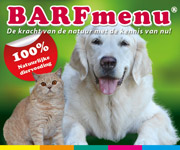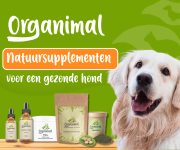Ik heb iets gevonden betreffende lacto-fermented veggies, het staat helemaal onderaan (zonder granen dus, en in dit artikel wordt uitgelegd waarom je beter geen granen gebruikt):
http://www.whole-dog-journal.com/.../Canine_Cance
The Whole Dog Journal
The right diet
....Advocates of home-prepared diets for dogs have long claimed that their animals are healthier than they would be on commercial pet food. Beth Taylor and Steve Brown, authors of See Spot Live Longer, agree. They blame dry and canned dog foods for a host of problems because they usually contain inferior-quality proteins, fats, and carbohydrates, a variety of toxins, highly processed grains, chemical preservatives, allergens, and other questionable ingredients.
Many veterinarians blame grain-based pet foods for diabetes, digestive problems, and other canine disorders. After all, the canine digestive tract evolved on a diet of prey animals, consisting mostly of meat and bones, not wheat and corn.
Every few years, aflatoxin, which grows on corn, rice, and other grains, contaminates pet foods and kills dogs (see “Yes, Dog Food Can Kill,” February 2006). In addition to causing liver damage, aflatoxin is a potent carcinogen, so even “safe” levels that don’t cause obvious disease outbreaks can contribute, over time, to cancer.
Another carcinogen found in grain-based foods is acrylamide, once believed to exist only in industrial waste. However, acrylamide has recently been found almost everywhere in the human diet. This tasteless, invisible by-product is formed when high-carbohydrate foods are fried or baked at high temperatures. French fries and potato chips contain the highest concentrations, but acrylamide occurs in breads and breakfast cereals as well.
The U.S. Environmental Protection Agency (EPA) considers acrylamide so dangerous that it set the “safe level” for human consumption at almost zero, with the maximum safe level in drinking water set at 0.5 parts per billion. A small serving of French fries contains over 400 parts per billion. No one has tested pet foods, but any processed foods that contain carbohydrates, especially those extruded at high temperature like grain-based kibble or canned under high heat and pressure, pose a risk.
“Considering how ubiquitous these carcinogens are,” says San Francisco-area dog health researcher Mary Straus, “and considering that cancer cells thrive on carbohydrates, avoiding grains altogether may be one way to help lower the risk of cancer.”
In addition to reducing levels of carbohydrates and carcinogens, feeding a home-prepared diet of pasture-fed, organically produced ingredients (see “Upgrading to Pasture-Fed,” July 2003) insures that your dog will not ingest pesticide and drug residues. Food prepared at home from conventionally farmed ingredients may not be free of pesticide residues, but it is unlikely to contain chemical preservatives, artificial colors or flavors, or the by-products of high-heat processing.
In his book, Work Wonders: Feed Your Dog Raw Meaty Bones, Australian veterinarian Tom Lonsdale observes, “We need more information about the cancer epidemic in domestic dogs. However, basic nutritional and medical principles tell us that diet is the likely main factor. Without waiting for extra information, and because cancer often takes years to develop, it’s best to start puppies on a cancer-prevention diet early. From the whelping box to the grave, let ‘Prevention, not treatment’ be our motto.”
Dietary supplements
Antioxidant supplements, which help protect the body from damage by free radicals, have many health benefits, including cancer protection. Best-selling antioxidant supplements include vitamins A, C, and E, beta carotene, lycopene, and the mineral selenium. Bear in mind that some alternative cancer treatments, such as artemisinin, are not compatible with antioxidants.
Food-source antioxidants, vitamins, and other nutrients derived from whole foods are recommended by many holistic veterinarians because they are recognized as food by the body and are more easily assimilated than synthetic vitamins grown in a laboratory. The words “whole food” or “food source” indicate natural rather than synthetic ingredients.
One of the simplest cancer-resisting supplements you can add to your dog’s food, according to Bruce Fife, ND, is coconut oil. Dr. Fife, the author of several books about coconut’s health benefits, recommends feeding dogs 1 teaspoon of coconut oil per 10 pounds of body weight per day in divided doses. That’s 1 tablespoon (3 teaspoons) for a 30-pound dog and 2 tablespoons for a 60-pound dog. (See “Crazy About Coconut Oil,” October 2005.)
“The medium-chain fatty acids in coconut oil help treat or prevent all kinds of illnesses,” he says, “and they have significant anti-tumor properties. Giving your dog coconut oil every day is inexpensive health insurance.”
Dried shredded coconut (the unsweetened kind) is an excellent source of fiber, another factor in cancer prevention. Try adding a teaspoon to a tablespoon of shredded coconut to your dog’s home-prepared food. If feeding dry food, add a little water or soak the shredded coconut first.
Vegetables are controversial ingredients because they’re hard for dogs to digest. But a simple lactofermentation process not only improves the digestibility and assimilation of vegetables, it increases their vitamin content and makes them a valuable source of beneficial bacteria. In fact, the treated vegetables are both a prebiotic (food that feeds beneficial bacteria) and probiotic (food that contains beneficial bacteria). In Europe, lactofermented vegetables are the key ingredient in a popular cancer treatment.
To make lactofermented vegetables (see “It’s All in How You Make It,” March 2001), simply grate, shred, or puree carrots and other vegetables, add 1½ teaspoons unrefined sea salt per quart (4 cups) of vegetables, add the contents of a probiotic supplement such as acidophilus, and press everything in a bowl or glass jar until juice covers the vegetables. (The task is made considerably easier with a Japanese salad press; see “Cancer Prevention Resources” for purchasing information.)
Close the jar tightly or, if using a bowl, cover vegetables with a plate weighted by a jar filled with water. Let stand at room tem-perature until the vegetables give off a vinegar-like fragrance; this will usually take two to three days, depending on their con-sistency and room temperature. Refrigerate. Use to replace vegetables in any home-prepared recipe, or add 1 tablespoon to ¼ cup lactofermented vegetables to each meal.







